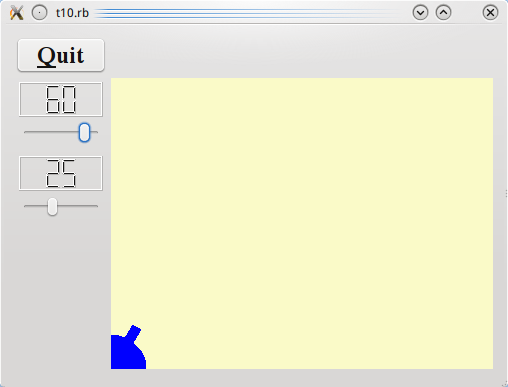Archive:Development/Tutorials/Qt4 Ruby Tutorial/Chapter 10 (zh TW): Difference between revisions
(Created page with '{{Template:I18n/Language Navigation Bar_(zh_TW)|Development/Tutorials/Qt4 Ruby Tutorial/Chapter 10}} {{TutorialBrowser_(zh_TW)| series=[[Development/Tutorials/Qt4_Ruby_Tutorial...') |
m (AnneW moved page Development/Tutorials/Qt4 Ruby Tutorial/Chapter 10 (zh TW) to Archive:Development/Tutorials/Qt4 Ruby Tutorial/Chapter 10 (zh TW) without leaving a redirect: Obsolete) |
||
| (3 intermediate revisions by 2 users not shown) | |||
| Line 9: | Line 9: | ||
pre=[[Development/Tutorials/Qt4_Ruby_Tutorial/Chapter_09_(zh_TW)|教學 9 - With Cannon You Can]]| | pre=[[Development/Tutorials/Qt4_Ruby_Tutorial/Chapter_09_(zh_TW)|教學 9 - With Cannon You Can]]| | ||
next=[[Development/Tutorials/Qt4_Ruby_Tutorial/ | next=[[Development/Tutorials/Qt4_Ruby_Tutorial/Chapter_11_(zh_TW)|教學 11 - Giving It a Shot]] | ||
}} | }} | ||
== Smooth as Silk == | == Smooth as Silk == | ||
| Line 19: | Line 19: | ||
===概覽=== | ===概覽=== | ||
在這個範例中,我們增加了力量(force)控制。 | |||
===一行一行的瀏覽=== | ===一行一行的瀏覽=== | ||
'''[http://www.darshancomputing.com/qt4-qtruby-tutorial/tutorial/t10/cannon.rb cannon.rb]''' | '''[http://www.darshancomputing.com/qt4-qtruby-tutorial/tutorial/t10/cannon.rb cannon.rb]''' | ||
'''<tt>CannonField</tt>''' 現在除了角度外,又加入力量值。 | |||
< | <syntaxhighlight lang="ruby"> | ||
signals 'angleChanged(int)', 'forceChanged(int)' | signals 'angleChanged(int)', 'forceChanged(int)' | ||
slots 'setAngle(int)', 'setForce(int)' | slots 'setAngle(int)', 'setForce(int)' | ||
</ | </syntaxhighlight> | ||
力量的介面遵循和角度相同的寫法。 | |||
< | <syntaxhighlight lang="ruby"> | ||
def initialize(parent = nil) | def initialize(parent = nil) | ||
super() | super() | ||
| Line 43: | Line 43: | ||
setAutoFillBackground(true) | setAutoFillBackground(true) | ||
end | end | ||
</ | </syntaxhighlight> | ||
力量 '''<tt>@currentForce</tt>''' 初始化為零。 | |||
< | <syntaxhighlight lang="ruby"> | ||
def setAngle(angle) | def setAngle(angle) | ||
if angle < 5 | if angle < 5 | ||
| Line 63: | Line 63: | ||
emit angleChanged(@currentAngle) | emit angleChanged(@currentAngle) | ||
end | end | ||
</ | </syntaxhighlight> | ||
我們在 '''<tt>setAngle()</tt>''' 函式作了一點輕微的改變。它只有重畫 widget 中包含加農砲的部分。 | |||
< | <syntaxhighlight lang="ruby"> | ||
def setForce(force) | def setForce(force) | ||
if force < 0 | if force < 0 | ||
| Line 79: | Line 79: | ||
emit forceChanged(@currentForce) | emit forceChanged(@currentForce) | ||
end | end | ||
</ | </syntaxhighlight> | ||
'''<tt>setForce()</tt>''' 的實現相當類似 '''<tt>setAngle()</tt>'''。唯一的差別是,因為我們沒有顯示力量值,所以不需要重繪 widget。 | |||
< | <syntaxhighlight lang="ruby"> | ||
def paintEvent(event) | def paintEvent(event) | ||
painter = Qt::Painter.new(self) | painter = Qt::Painter.new(self) | ||
| Line 96: | Line 96: | ||
painter.end() | painter.end() | ||
end | end | ||
</ | </syntaxhighlight> | ||
我們像第9章一樣繪製。 | |||
< | <syntaxhighlight lang="ruby"> | ||
def cannonRect() | def cannonRect() | ||
result = Qt::Rect.new(0, 0, 50, 50) | result = Qt::Rect.new(0, 0, 50, 50) | ||
| Line 106: | Line 106: | ||
return result | return result | ||
end | end | ||
</ | </syntaxhighlight> | ||
'''<tt>cannonRect()</tt>''' 函式返回 widget 坐標中封裝加農砲的矩形。首先,我們建立一個大小50×50的矩形。然後移動它,所以它的左下角等同於 widget 自己的左下角。 | |||
[http://doc.qt.nokia.com/latest/qwidget.html#rect-prop Qt::Widget::rect()] 函式返回在 widget 坐標中封裝 widget 自己矩形。矩形的左上角永遠是(0,0)。 | |||
'''[http://www.darshancomputing.com/qt4-qtruby-tutorial/tutorial/t10/t10.rb t10.rb]''' | '''[http://www.darshancomputing.com/qt4-qtruby-tutorial/tutorial/t10/t10.rb t10.rb]''' | ||
建構子大部分相同,但新增了一些東西。 | |||
< | <syntaxhighlight lang="ruby"> | ||
force = LCDRange.new() | force = LCDRange.new() | ||
force.setRange(10, 50) | force.setRange(10, 50) | ||
</ | </syntaxhighlight> | ||
我們加入第二個 '''<tt>LCDRange</tt>''',用來設定力量。 | |||
< | <syntaxhighlight lang="ruby"> | ||
connect(force, SIGNAL('valueChanged(int)'), | connect(force, SIGNAL('valueChanged(int)'), | ||
cannonField, SLOT('setForce(int)')) | cannonField, SLOT('setForce(int)')) | ||
connect(cannonField, SIGNAL('forceChanged(int)'), | connect(cannonField, SIGNAL('forceChanged(int)'), | ||
force, SLOT('setValue(int)')) | force, SLOT('setValue(int)')) | ||
</ | </syntaxhighlight> | ||
我們連接 '''<tt>force</tt>''' widget 和 '''<tt>cannonField</tt>''' widget,就像我們為 '''<tt>angle</tt>''' widget 所作的。 | |||
< | <syntaxhighlight lang="ruby"> | ||
leftLayout = Qt::VBoxLayout.new() | leftLayout = Qt::VBoxLayout.new() | ||
leftLayout.addWidget(angle) | leftLayout.addWidget(angle) | ||
| Line 142: | Line 142: | ||
gridLayout.addWidget(cannonField, 1, 1, 2, 1) | gridLayout.addWidget(cannonField, 1, 1, 2, 1) | ||
gridLayout.setColumnStretch(1, 10) | gridLayout.setColumnStretch(1, 10) | ||
</ | </syntaxhighlight> | ||
在第9章中,我們把 '''<tt>angle</tt>''' 放在佈局的左下格。現在,我們想有兩個 widget在該格中,所以我們做一個 vertical box,把 vertical box 放在網格中,並且把 '''<tt>angle</tt>''' 和 '''<tt>range</tt>''' 放入 vertical box。 | |||
< | <syntaxhighlight lang="ruby"> | ||
force.setValue(25) | force.setValue(25) | ||
</ | </syntaxhighlight> | ||
我們初始化力量值為25。 | |||
===執行應用程式=== | ===執行應用程式=== | ||
我們現在有力量控制了。 | |||
===練習=== | ===練習=== | ||
使砲管的大小依據力量的變化。 | |||
把加農砲放在右下角。 | |||
嘗試增加一個更好的鍵盤介面。例如,用+和-來增加和減少力量,並用 enter 發射。如果你對'''<tt>左</tt>'''和'''<tt>右</tt>'''方向鍵的運作的方式感到困擾,也更改它吧。[提示:重新實作 [http://doc.qt.nokia.com/latest/qwidget.html#keyPressEvent Qt::Widget::keyPressEvent()]。] | |||
[[Category:Ruby]] | [[Category:Ruby]] | ||
Latest revision as of 15:54, 23 June 2013
Template:I18n/Language Navigation Bar (zh TW)
Template:TutorialBrowser (zh TW)
Smooth as Silk

檔案:
概覽
在這個範例中,我們增加了力量(force)控制。
一行一行的瀏覽
CannonField 現在除了角度外,又加入力量值。
signals 'angleChanged(int)', 'forceChanged(int)'
slots 'setAngle(int)', 'setForce(int)'
力量的介面遵循和角度相同的寫法。
def initialize(parent = nil)
super()
@currentAngle = 45
@currentForce = 0
setPalette(Qt::Palette.new(Qt::Color.new(250, 250, 200)))
setAutoFillBackground(true)
end
力量 @currentForce 初始化為零。
def setAngle(angle)
if angle < 5
angle = 5
elsif angle > 70
angle = 70
end
if @currentAngle == angle
return
end
@currentAngle = angle
update(cannonRect())
emit angleChanged(@currentAngle)
end
我們在 setAngle() 函式作了一點輕微的改變。它只有重畫 widget 中包含加農砲的部分。
def setForce(force)
if force < 0
force = 0
end
if @currentForce == force
return
end
@currentForce = force
emit forceChanged(@currentForce)
end
setForce() 的實現相當類似 setAngle()。唯一的差別是,因為我們沒有顯示力量值,所以不需要重繪 widget。
def paintEvent(event)
painter = Qt::Painter.new(self)
painter.setPen(Qt::NoPen)
painter.setBrush(Qt::Brush.new(Qt::blue))
painter.translate(0, height())
painter.drawPie(Qt::Rect.new(-35, -35, 70, 70), 0, 90 * 16)
painter.rotate(-@currentAngle)
painter.drawRect(Qt::Rect.new(30, -5, 20, 10))
painter.end()
end
我們像第9章一樣繪製。
def cannonRect()
result = Qt::Rect.new(0, 0, 50, 50)
result.moveBottomLeft(rect().bottomLeft())
return result
end
cannonRect() 函式返回 widget 坐標中封裝加農砲的矩形。首先,我們建立一個大小50×50的矩形。然後移動它,所以它的左下角等同於 widget 自己的左下角。
Qt::Widget::rect() 函式返回在 widget 坐標中封裝 widget 自己矩形。矩形的左上角永遠是(0,0)。
建構子大部分相同,但新增了一些東西。
force = LCDRange.new()
force.setRange(10, 50)
我們加入第二個 LCDRange,用來設定力量。
connect(force, SIGNAL('valueChanged(int)'),
cannonField, SLOT('setForce(int)'))
connect(cannonField, SIGNAL('forceChanged(int)'),
force, SLOT('setValue(int)'))
我們連接 force widget 和 cannonField widget,就像我們為 angle widget 所作的。
leftLayout = Qt::VBoxLayout.new()
leftLayout.addWidget(angle)
leftLayout.addWidget(force)
gridLayout = Qt::GridLayout.new()
gridLayout.addWidget(quit, 0, 0)
gridLayout.addLayout(leftLayout, 1, 0)
gridLayout.addWidget(cannonField, 1, 1, 2, 1)
gridLayout.setColumnStretch(1, 10)
在第9章中,我們把 angle 放在佈局的左下格。現在,我們想有兩個 widget在該格中,所以我們做一個 vertical box,把 vertical box 放在網格中,並且把 angle 和 range 放入 vertical box。
force.setValue(25)
我們初始化力量值為25。
執行應用程式
我們現在有力量控制了。
練習
使砲管的大小依據力量的變化。
把加農砲放在右下角。
嘗試增加一個更好的鍵盤介面。例如,用+和-來增加和減少力量,並用 enter 發射。如果你對左和右方向鍵的運作的方式感到困擾,也更改它吧。[提示:重新實作 Qt::Widget::keyPressEvent()。]
